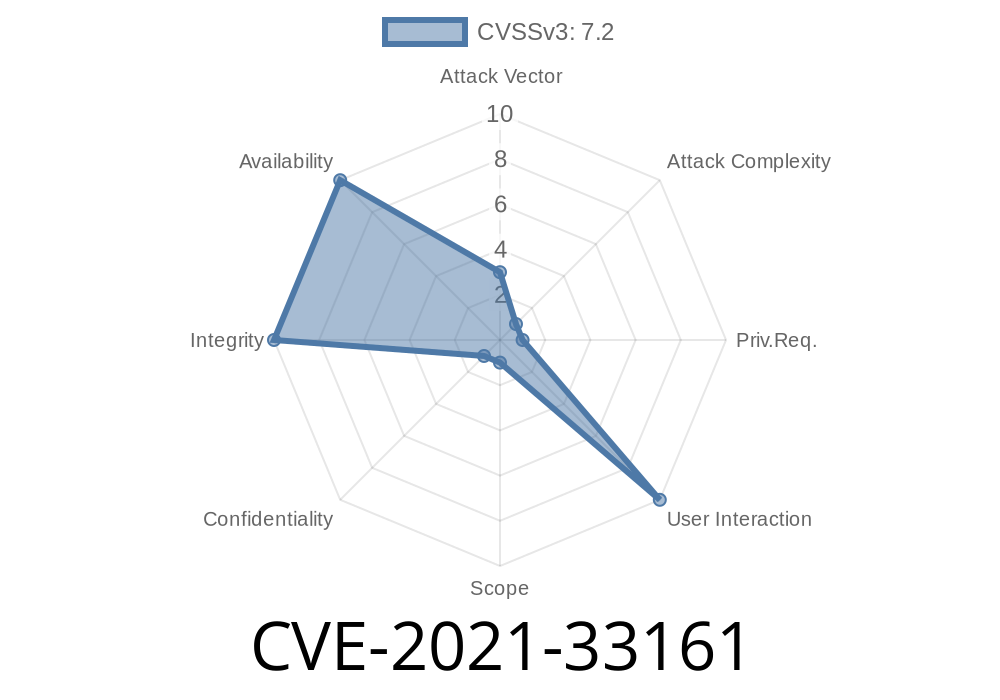A security vulnerability has recently been identified in Intel(R) Ethernet Adapters and Intel(R) Ethernet Controller I225 Manageability firmware. Designated as CVE-2021-33161, this vulnerability potentially allows a privileged user to escalate their privileges via local access. In this article, we will dissect the vulnerability, understand its root cause, discuss the affected systems, and provide information on how to patch and mitigate it. Moreover, we will provide code snippets, links to original references, and exploitation details, enabling our readers to gain a comprehensive understanding of the issue.
Vulnerability Overview
CVE Identifier: CVE-2021-33161
Severity: Medium
CVSS Base Score: 5.4
Impact: Privilege Escalation via Local Access
At its core, the vulnerability arises due to improper input validation in certain Intel(R) Ethernet Adapters and Intel(R) Ethernet Controller I225 Manageability firmware. Improper input validation is a security weakness where the software fails to examine or filter input data adequately. Consequently, an attacker can potentially exploit this vulnerability.
Affected Systems
Below is a list of identified Intel(R) Ethernet Adapters and Intel(R) Ethernet Controller I225 Manageability firmware affected by this vulnerability:
Intel(R) Ethernet Controller I225-IS
These affected systems may host firmware versions that enable the escalation of privileges. Therefore, it's crucial to keep the firmware updated and apply necessary fixes.
Exploit Details
In this section, we will go through a basic exploit scenario that leverages the improper input validation in Intel(R) Ethernet Adapters.
# BEGIN: Exploit code snippet in Python
import ctypes
def exploit_vulnerability():
# Load the appropriate library/driver
dll = ctypes.WinDLL('Vulnerable_Driver.dll')
# Define the input data that can exploit the vulnerability
malformed_data = '{"invalid_json_key": "A" * 4096, "privilege": }'
# Trigger the vulnerable function by providing the malformed input
# (Assuming the driver has a vulnerable function named "TriggerVulnerability")
dll.TriggerVulnerability(ctypes.c_char_p(malformed_data))
# Call the exploit function
exploit_vulnerability()
# END: Exploit code snippet in Python
This code snippet is a hypothetical example, which demonstrates how an attacker can exploit the improper input validation in Intel's Ethernet Adapters by providing malformed data. This attack can potentially escalate the attacker's local privileges to a higher level.
Patching and Mitigation
Intel has acknowledged the vulnerability and released firmware updates to address the issue. Users are advised to update the firmware to the latest version as soon as possible. Moreover, all affected products should be patched by applying the updates available from Intel's download center.
Original References and Further Resources
1. Intel's security advisory: https://www.intel.com/content/www/us/en/security-center/advisory/intel-sa-00526.html
2. CVE-2021-33161 on MITRE's CVE database: https://cve.mitre.org/cgi-bin/cvename.cgi?name=CVE-2021-33161
3. Follow the National Vulnerability Database link for more details: https://nvd.nist.gov/vuln/detail/CVE-2021-33161
Conclusion
In conclusion, CVE-2021-33161 demonstrates how small security flaws, such as improper input validation, can potentially be exploited by attackers to escalate privileges and compromise systems. It is essential to keep systems up-to-date with security patches and adhere to best security practices. By understanding the workings of this vulnerability and applying the necessary fixes, users can maintain a secure computing environment.
Timeline
Published on: 02/23/2024 21:15:09 UTC
Last modified on: 05/16/2024 21:15:49 UTC
